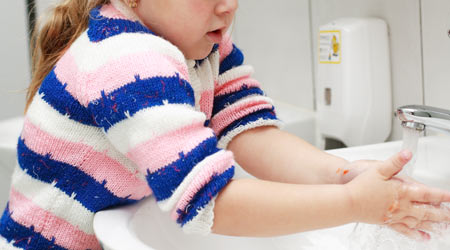
The bitter cold hitting your face and mounds of snowfall at your feet is the first indication to start staying indoors and turn the thermometer up a few notches – but it’s also a warning sign that cold and flu season has arrived. With the chill outside trapping everyone inside, germs spread more quickly and can wreak havoc at home and within schools, but is best known to directly strike the hustling and bustling workplace.
Sick leave due to colds is currently estimated to cost U.S. businesses $576 billion each year. Given that 80 percent of all infections are transmitted by hands, regular handwashing with soap is widely seen as one of the most effective ways to prevent the spread of germs and bacteria – and avoid infections. This practice could reduce the number of people catching colds by 45 percent, according to estimates.
In order to avoid and prevent as many cold and flu infections this winter, it’s vital that employers train, educate and continually remind employees about the importance of regular handwashing, including the proper technique and amount of soap to use. By implementing a hand hygiene program, companies can help prevent the spread of germs, protect its employees, save on costs, and create a more healthy and productive working environment.
It’s all in the Hands
Hands are the main transmitter of germs due to their basic function – carrying out most, if not all, of our tasks throughout the working day. A study done by University of Arizona discovered how quickly the flu spreads in the workspace with a mimicked flu experiment, starting with only one contaminated employee. The study found that within four hours, over 50 percent of surfaces and employees were contaminated. Hands frequently come in contact with germ hotspots, including:
• Mobile phones
• Keyboards
• Door handles
• Staircase rails
• Vending machines
• Other hands
Without even realizing it, hands are also used to cover coughing mouths, wipe runny noses and rub itchy eyes, making it easy for germs to transmit or infect. Think of it this way: when it comes to staying healthy and productive at work, hand hygiene should be as much of a priority as healthy eating and getting enough sleep.
Creating a Solution
Unfortunately, people don’t wash their hands frequently or adequately enough to successfully fight back against cold and flu infections. According to a study done by Michigan State University, only 5 percent of people wash their hands correctly, leaving 95 percent cutting corners when it comes to preventing the spread of infections.
Handwashing does seem like a simple enough solution to implement without much training, yet the average person washes their hands for only around 10 seconds, which at best will remove about 90 percent of germs. That may sound like a great outcome, but bacteria will grow and can double in numbers in less than 20 minutes. And in 80 minutes, those washed off germs can be back to the same number prior to washing.
One of the best ways to reinforce best handwashing techniques during this critical season is to implement an effective hand hygiene program in the workplace. These programs can help influence and remind employees to take hand hygiene more seriously.
A successful hang hygiene program should include:
• Proper handwashing products. Some facilities require different levels of hand hygiene and skin care from others, so it’s important to find the best, most cost-effective option. For example, foam soaps tend to require less product for an effective hand wash, resulting in longer use and cost savings.
• Accessible hand sanitizers. Hand sanitizers with at least 60 percent alcohol should be easily accessible throughout a facility. This includes individual desks, near doorways and at food consuming areas such as cafeterias.
• Prevention awareness signs and posters. By placing infographics and tip-filled posters on how to correctly wash hands, how much soap to use and other ways to stay healthy help keep employees focused on the importance of hand hygiene at work. These posters should be placed at critical handwashing areas such as restrooms, kitchens and high-traffic areas like hallways and lobbies.
• Education sessions for all employees. Many workers still show up to work despite knowing they’re ill and contagious, putting many other employees and your brand at risk. In order to limit unplanned sick days, conduct education sessions on identifying cold and flu symptoms.
Clean Hands to the Rescue
In addition to getting the flu vaccine and staying home if ill, the best and easiest way everyone can prevent the spread of cold and flu infections within the workplace is to actively keep hands clean. During the peak months of cold and flu season (December – March), it’s crucial to take extra precaution when it comes to hand hygiene. Enforcing an effective hand hygiene program will help keep an office or facility as clean and safe as possible, enhance productivity and produce an overall healthier working environment.
This article was written by Andreas Klotz, a Sr. Technical Product Manager at Deb Group, the world's largest leading away-from-home skin care company. He holds extensive experience in professional skin care products to prevent work related occupational skin diseases. After completing his Bachelor at University of Applied Sciences in Germany with a specialization in skin care and detergents, he worked in R&D and Marketing for Stoko in Europe for 17 years before he became a Sr. Marketing Manager with Stoko in the USA in 2012.

 The Down and Dirty on Cleaning in Virus Season
The Down and Dirty on Cleaning in Virus Season How Surfactant Use is Expanding in Commercial Cleaning
How Surfactant Use is Expanding in Commercial Cleaning Clean Buildings Conference
Clean Buildings Conference